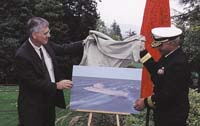Navy announces new class of ships
Open gallery

U.S. Secretary of the Navy Richard Danzig chose Lewis & Clark as the site to announce a new class of ships.
The first two of the forthcoming 12 supply ships, the U.S.S. Lewis and Clark and the U.S.S. Sacagawea, are due in 2004. The ships will carry food, fuel, spare parts and ammunition to replenish other ships.
The Oct. 27 event began with a moment of silence to honor the service men and women of the U.S.S. Cole who died because of a terrorist act 10 days earlier.
“The naming of this class of ships reminds us that the Corps of Discovery was made up of courageous individuals who—like members of the U.S.S. Cole—journeyed as a team, accepted great risk on behalf of their country and changed forever how we think of ourselves as Americans,” said Michael Mooney, president of Lewis & Clark College.
“This is a privilege three times over,” Danzig said. “First, we are naming the first ship in this class Lewis and Clark; second, we have the opportunity to name a ship after an Indian woman, Sacagawea; and third, this is a whole class of ships, and this whole class will bear the name of the first ship, Lewis and Clark.
Danzig said he chose to name the ships at the College because the College carries on the spirit of those explorers.
“With all of the wonderful credentials that so many of us have today, none of us has done anything that even begins to touch what Lewis and Clark accomplished,” Danzig commented.
“It’s impressive that Meriwether Lewis and William Clark were in their early 30s, that the men they led were in their 20s, and that Sacagawea was a teenager,” Danzig said, noting that the average age of a sailor on the platform of an aircraft carrier is 19. “We’re reminded of it at moments of tragedy like the U.S.S. Cole,” he said, “and at times of great joy.”
Jana Prewitt, assistant to the secretary and director of external affairs for the U.S. Department of Interior, underscored the significance of naming a ship after Sacagawea, a young Native American, who proved pivotal to the success of the journey. David Borlaug, president of the National Council of the Lewis and Clark Bicentennial, also spoke.
More L&C Magazine Stories
Lewis & Clark Magazine is located in McAfee on the Undergraduate Campus.
MSC: 19
email magazine@lclark.edu
voice 503-768-7970
fax 503-768-7969
The L&C Magazine staff welcomes letters and emails from readers about topics covered in the magazine. Correspondence must include your name and location and may be edited.
Lewis & Clark Magazine
Lewis & Clark
615 S. Palatine Hill Road MSC 19
Portland OR 97219

